We Got the Beat
William & Mary’s concert scene has kept the rhythm going for generations of students
October 1, 2025
Story By
Mary Beth Bauermann ’24
Photo Illustrations By
Sabrina Bryan
Skateboarding up and down the hills of William & Mary’s campus in April 1975, Dennis Wilson of The Beach Boys cheerfully greeted everyone he met. Unexpected encounters with the freewheeling drummer are among many stories shared by alumni about visiting musical acts that rocked the university’s stages over the past 60 years.
Deadheads camped out on the lawn at Yates Hall. Students frolicked in a Bruce Hornsby & The Range video. The Roots’ Ahmir “Questlove” Thompson danced in the stands with the audience. Concerts that alumni attended at William & Mary are among the most vivid memories of their time as students. For some, the shows marked the beginning of a great romance or a bonding experience with lifelong friends. For others, they were a chance to gain an inside look at planning and running a performance. The concerts also helped define each time period with cultural touchstones.
W&M Concert Highlights
Cat Stevens, Muddy Waters, Eric Clapton, Boston, The Pretenders and many other famous performers have appeared at William & Mary over the years. Check out our photo gallery.
ViewWilliam & Mary Hall (named Kaplan Arena since 2016) has drawn the Grateful Dead, Chicago, Bruce Springsteen, Alice Cooper, The Kinks, Joni Mitchell, Neil Young, Nirvana, The Go-Go’s, R.E.M., Jimmy Buffett, Tom Petty, Kendrick Lamar, Ludacris and The Roots, among many others. While the artists and music styles have changed over the years, the university community continues to “dance to the music,” as the late Sly Stone sang at the inaugural William & Mary Hall concert in 1971.
Initially, concerts took place at Blow Gym (now Blow Memorial Hall), which opened in 1925, and Phi Beta Kappa Memorial Hall. Early shows included Captain Kangaroo’s Children’s Concert, a 1969 Homecoming concert featuring Martha Reeves and the Vandellas with Rhinoceros, the Impressions and an IFC concert featuring rock groups Classics IV and Lighthouse. According to the 1970 edition of the Colonial Echo, members of Sigma Pi hosted The Classics IV for refreshments after their performance. Bill Gibbons ’72, P ’14, P ’17 and Bill Monday ’72 remember fondly The 5th Dimension in 1969. For Monday, the concert was his first on-campus date with his future wife.
Dean Strickland ’76 attended some of the first concerts at William & Mary Hall while still in high school and later worked backstage as a student liaison. “I was right in the middle of it,” he says.
GOOD VIBRATIONS
Filling the need for a larger athletic arena that would replace Blow Gym, William & Mary Hall opened in December 1970. The first concert featured Sly and the Family Stone on Sept. 24, 1971, and was attended by 6,800 fans, who “shouted and stamped their approval of the charismatic star” and danced in the aisles, according to a 1971 Daily Press review.
Strickland was a keyboardist and vocalist in local bands including Stonehenge and Fox that played at W&M during his time at the university. Looking for student input, Lester Hooker ’43, M.Ed. ’48, P ’69, the director of William & Mary Hall at the time, recruited him to fill a student liaison position for the venue. Strickland also held leadership positions in the Student Association, the primary student organization facilitating the concerts. As a result, he had a front row seat to almost every William & Mary concert from 1974 to 1976. Strickland says he worked backstage for 80-90% of the shows, only missing a performance if his own band had a gig the same night.
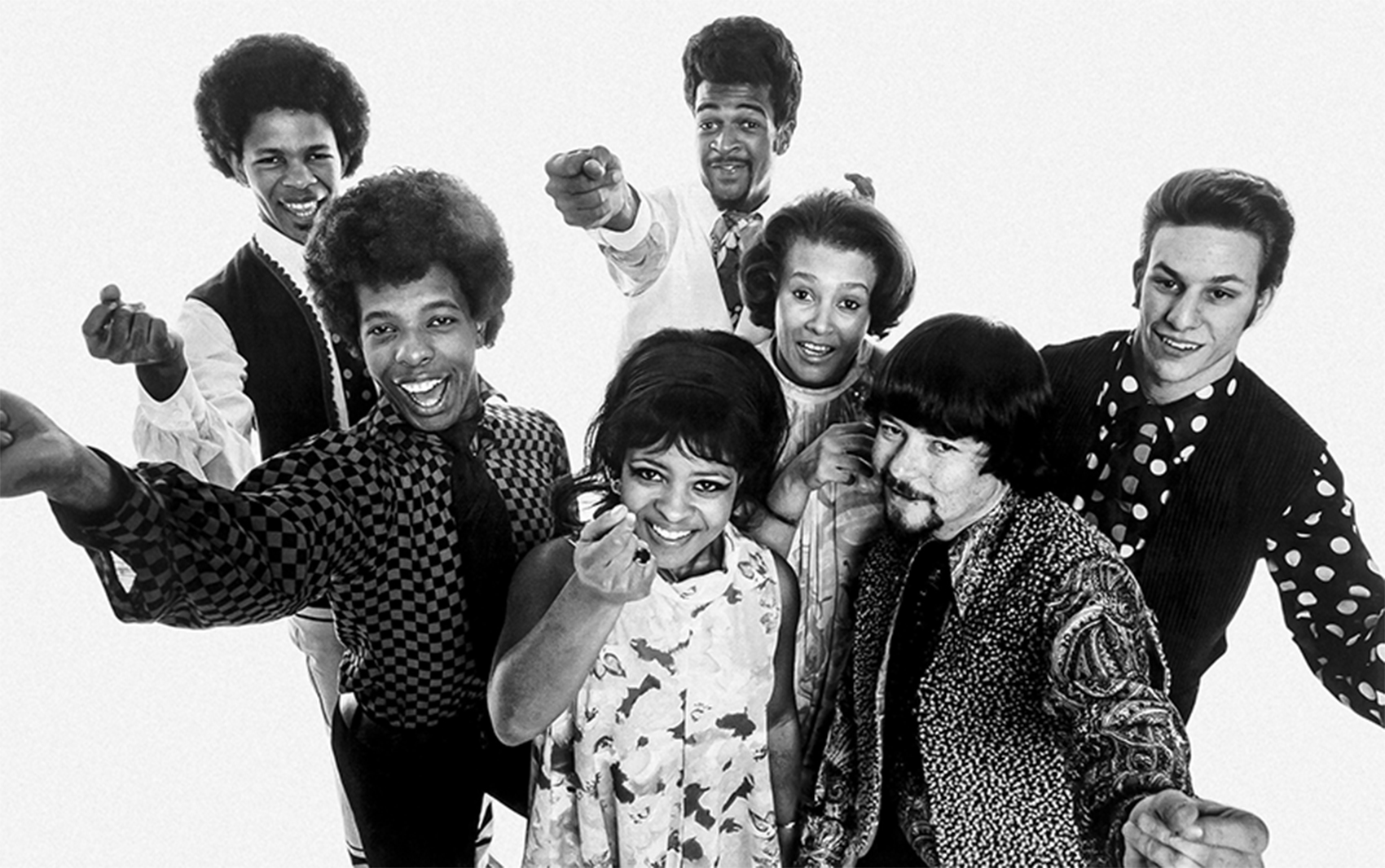
Now a retired attorney living in Florida, Strickland has constructed a list of every W&M concert between 1972 and 1976, which boasts such legendary names as James Taylor, Fleetwood Mac and Jefferson Starship, among many others. He has fond backstage memories, as well. The Beach Boys, he says, “had a big spread of fruit, vegetables and cheeses backstage and invited the student stage crew and security officers to partake.”
Strickland also snagged a unique keepsake from the band: “I grabbed a broken drumhead that Dennis was tossing out, got Carl Wilson and Al Jardine to sign it, and gave it to my brother, who was an aspiring drummer at the time.” He adds that not long after The Beach Boys’ Williamsburg gig, Dennis Wilson broke his arm while skateboarding elsewhere.
The Grateful Dead’s 1973 show turned into two consecutive nights of music. Dave Hinder ’72, M.B.A. ’75 (who initially suggested this article) remembers that the Dead played for four hours and, at the end of the show, announced that they would return the next night for just $3 per ticket. The band’s 1978 concert was recorded and is part of the “Dave’s Picks” series of Grateful Dead archival releases, named for the band’s audiovisual archivist, David Lemieux. The album “Dave’s Picks: Volume 37,” released in 2021, features an illustration of a William & Mary dorm room on the cover.
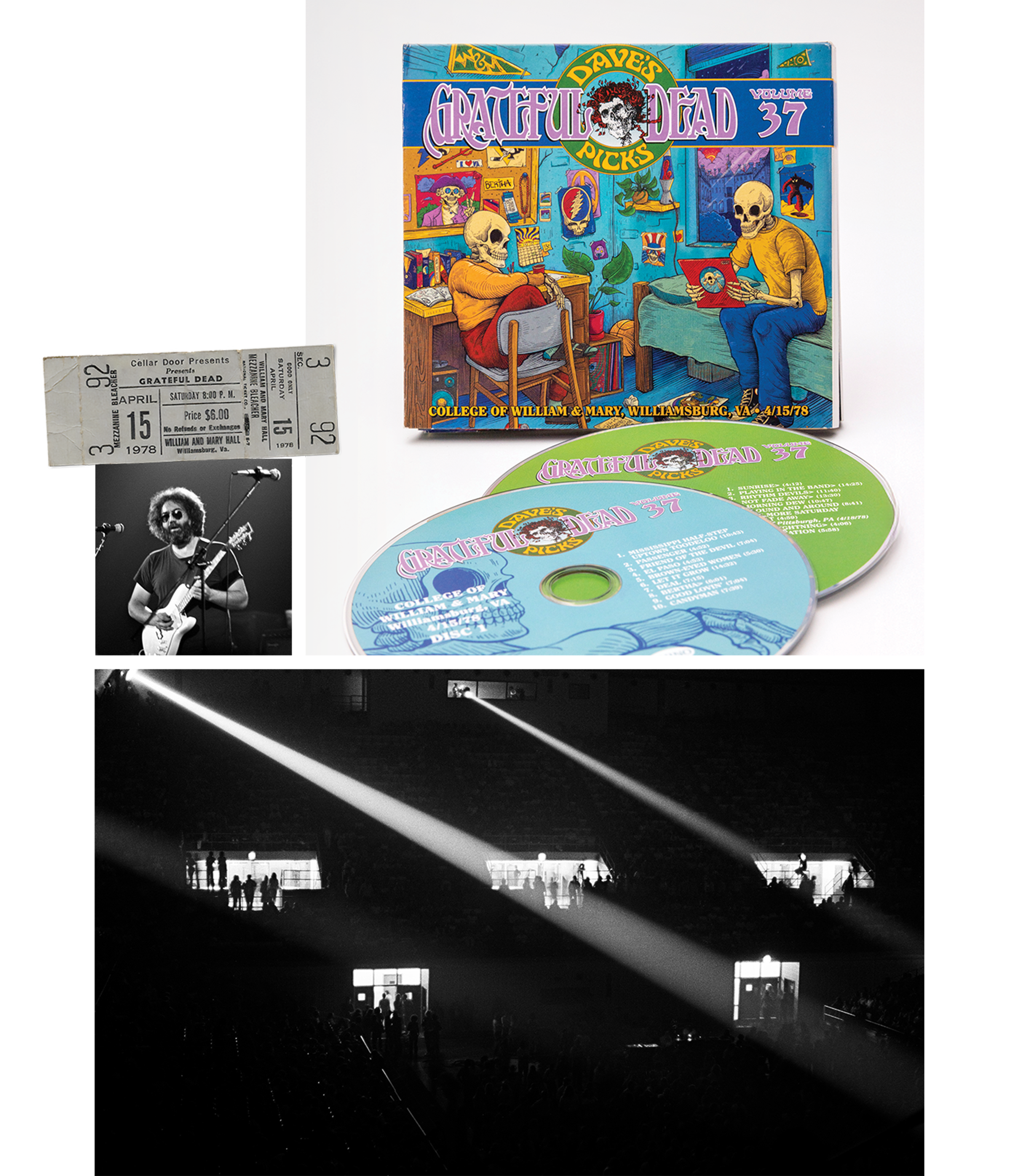
As much as the William & Mary community appreciated the concerts, the artists also seemed to enjoy playing at William & Mary Hall. In a letter shared in The Flat Hat shortly after the concert in April 1975, The Beach Boys’ road manager, Rick Nelson, wrote a thank you message:
“TO THE PEOPLE AT WILLIAM & MARY HALL: The concert on April 7th was the best on our tour. The facilities were great and the backstage crew had everything together. The crowd was fantastic and we appreciated the reception. We now know that Tidewater Virginia and the College of William & Mary are truly BEACH BOYS fans! We understand that this is just the beginning of great concerts to come. If things continue to go as well as they did for us, everything will be beautiful in the future. Good Luck!”
What led to the influx of concerts during the ’70s? As Strickland notes in a September 1975 article for The Flat Hat, “television concerts like ‘In Concert’ and ‘The Midnight Special’ were nonexistent, and the avalanche of stereo and quadrophonic systems had just started to mount.”
In 1974, David Ryan ’75, the student liaison who preceded Strickland, conducted a rock concert survey and, according to Strickland, “made strong appeals to the administration to obtain more favorable terms to attract promoters and groups.” In 1973 and 1974, W&M Hall had only welcomed a few major acts, and the student body demanded more concerts.
Strickland remembers a gas crisis that made concert promoters apprehensive about transportation costs for performers and for fans. In the same 1975 Flat Hat article, he explained, “Inability on the part of promoters to make substantial profits has led to a steady decline in the number of concerts William & Mary has been able to present during the five-year existence of the hall.”
Strickland continued: “Despite conscientious efforts by the Student Association to increase use and effectiveness of campus communications, rumors of concerts and cancellations continue to haunt William & Mary Hall. It’s easy to criticize the evolution of a 10,800-seat facility from a widely reputed ‘no-hassle’ hall in its early days to a ‘no concert’ hall as of late. But how many people understand the problems that have plagued concert promoters, not only here, but across the nation?”
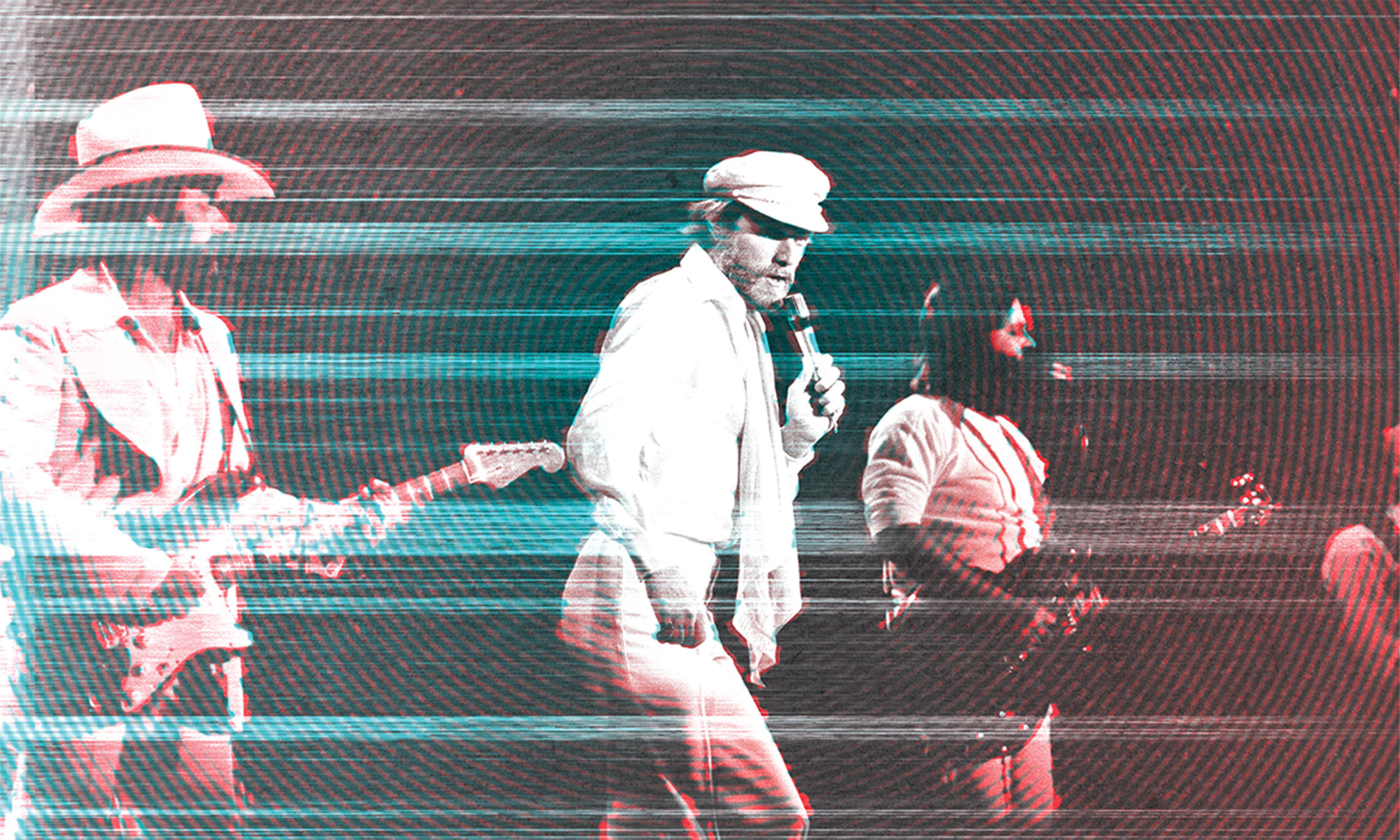
EVERY LITTLE THING
In The Flat Hat article, Strickland emphasized organizers’ commitment to providing concerts. “We’re here to listen and bring the concert tradition back to William & Mary,” he wrote.
The efforts led to renewed concert success in the fall of 1975 and into the 1980s. Rock trio The Police visited W&M twice — once in 1982 as a stop on their “Ghost in the Machine” tour, and again in 1984 for their “Synchronicity” tour.
Alan Adenan ’89 remembers seeing The Police at W&M Hall in 1984, as well as R.E.M. twice, in 1986 and 1987. “R.E.M. was huge at the time,” he says. “Students used to call the radio station (WCWM 90.9) ‘WREM’” due to the DJs’ tendencies to fill the airwaves with the band’s music. Adenan also saw Jimmy Buffett on the Fourth of July at Cary Field, an outdoor concert spot that is now the site of Zable Stadium. Still an avid music fan, he fondly remembers standing in line to get tickets and enjoying concerts from the floor of W&M Hall, where he could see the band up close.
Adenan also had a front-row seat when hometown celebrity Bruce Hornsby and his band The Range shot a music video for their 1988 hit song “The Valley Road” in Blow Gym. Adenan walked out of his dorm next door in the Bryan Complex and noticed the truck for a familiar lighting company, Washington Source. As a student assistant for William & Mary TV and a freelance grip in Colonial Williamsburg, Adenan recognized one of the lighting company’s gaffers and was offered an opportunity to help with the video. “It was a great experience. I got to see the evolution of shooting a music video,” he says.
Adenan remembers that comedian, actor and author Patton Oswalt ’91, D.A. ’23 appeared in the music video, during the Blow Gym basketball court scene. In the video, several W&M students and community members dance around the band. He says that the video’s director asked Oswalt to do something different, which is why he notably duckwalks in the video. Adenan and many other alumni remember Blow Gym as a space for undergrads, “so the video means more now that Blow isn’t a gym anymore,” he says. Adenan saw Hornsby again while working as a busser at the Williamsburg Inn after graduating, when he dropped by to play at the piano bar. Adenan now works as a chef, but he is still an avid music fan and concertgoer.
During the ’80s, William & Mary Hall drew big names such as The Cars and The Clash in 1982, The Pretenders with Stevie Ray Vaughan in 1984, and Love and Rockets with the Pixies in 1989. William & Mary students did not have to travel far for great live music. Beyond the major concerts, Adenan adds, “there were also great local bands in Williamsburg who played at the Green Leafe.”
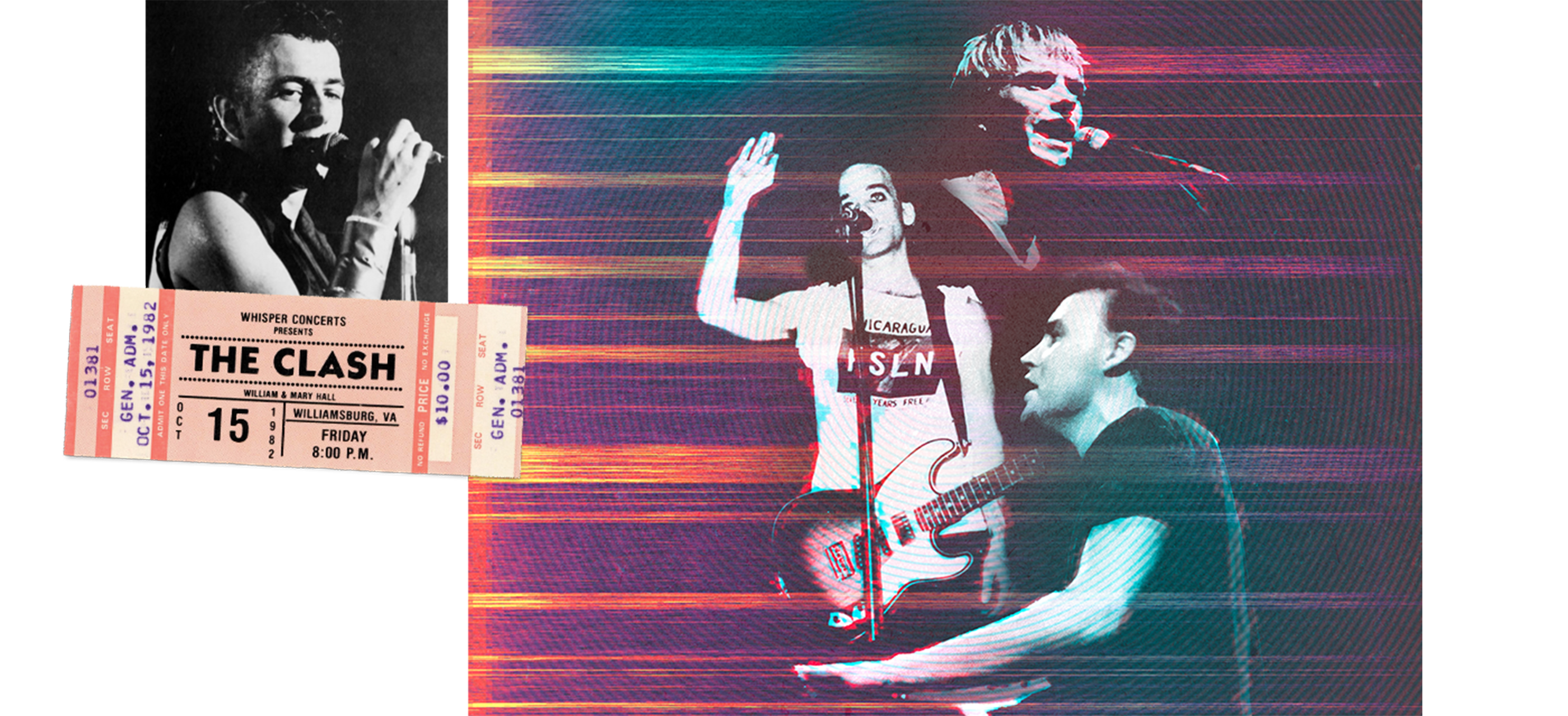
HERE WE ARE NOW, ENTERTAIN US
Popular headliners continued into the ’90s, including Nirvana on Nov. 7, 1993. At the time, the band was at the peak of its fame, and the William & Mary show was one of the final concerts before lead singer Kurt Cobain’s death in 1994. Ari Rosberg ’96, then photo editor for The Flat Hat, attended and had a once-in-a-lifetime opportunity to photograph the concert. The 18-wheelers parked on campus fueled a buzz in the campus community.
Rosberg describes the energy of the crowd as “rowdy.” According to an article in The Flat Hat, a concertgoer threw a shoe at Cobain’s head during the “Nevermind” hit “Lithium,” which resulted in the band having to stop and restart the song. The experience of taking photos “under the armpit of an extremely tall security guard, who picked people up and pushed them back into the crowd,” Rosberg says, was “equal parts exhilarating and terrifying.”
While the lighting in W&M Hall made it difficult to photograph the concert, Rosberg shot three rolls of film. “I had about four photos that I thought turned out,” he says. Many students took amateur photos. “The Williamsburg photo store was mobbed,” he says, but Rosberg developed his photos in The Flat Hat darkroom. His photos have been used on the Nirvana fan website livenirvana.com.
Students were eager to get their hands on the Nov. 12, 1993, issue of The Flat Hat. “This was unusual,” Rosberg says, “because people were not usually chomping at the bit to get their hands on The Flat Hat.” But students — especially those who missed out on seeing Nirvana — “wanted to see photos and hear firsthand accounts.”
Rosberg remembers that class attendance on Monday was noticeably low, as attendees seemed to experience a “communal hangover.” During his time at W&M, he also photographed W&M’s 300th anniversary, when former British Prime Minister Margaret Thatcher was on campus and named chancellor, “but nothing ever quite matched Nirvana,” he says.
In the ’90s, other major acts at William & Mary include The Cure in 1992, as well as Gin Blossoms and Smashing Pumpkins in 1994.
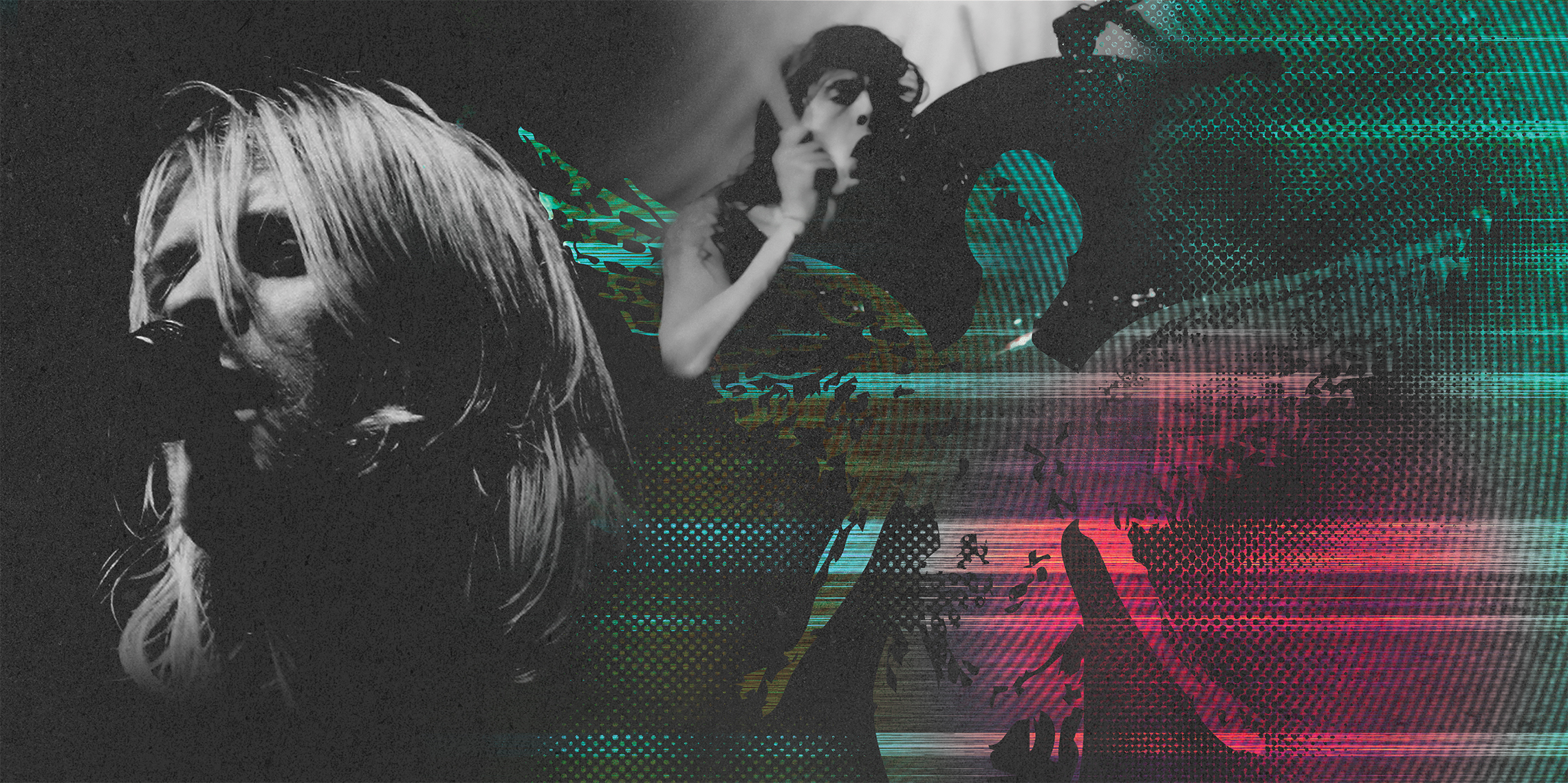
LISTEN AS WE GO
Following in the footsteps of Strickland, Adenan, Rosberg and many other students who had a chance to get up close and personal with the artists who visited W&M, Leah Wood Nelson ’02 planned concerts through the University Center Activities Board (UCAB), during the early 2000s. UCAB also planned Homebrew and Fridays at 5 performances on the University Center terrace (now Sadler terrace, where Fridays at 5 events are still held).
“I recall this being the brainchild of Sam Sadler ’64, M.Ed. ’71, who allocated us the funding and let us run with it,” Nelson says. To appeal to music fans across campus, she says, “We tried to get diverse acts that included a steel drum band and ’70s disco, in addition to our typical college rock bands.”
As chair of the Music Productions Committee for UCAB, Nelson called agents, representatives, sound companies and others to book artists and production companies. She also introduced Guster and Phantom Planet onstage when they played at W&M Hall in April 2002. Guster was a prominent band on the radio at the time, and Phantom Planet was up and coming. Their song “California” became the theme song of the show “The O.C.” A student band, Turning to Tucker, was the opener. Nelson remembers the energy on campus, and the excitement when actor Jason Schwartzman, who played drums in Phantom Planet, and another member of the band showed up at the Green Leafe after the show.
Through UCAB, Nelson often worked alongside staff members in the W&M Student Affairs office. Wanting to support students in a similar role, she pursued an M.Ed. in higher education after graduating from W&M. Now, working as a career coach at Brightpoint Community College, Nelson helps Virginia high school students explore their college and career pathways after graduation.
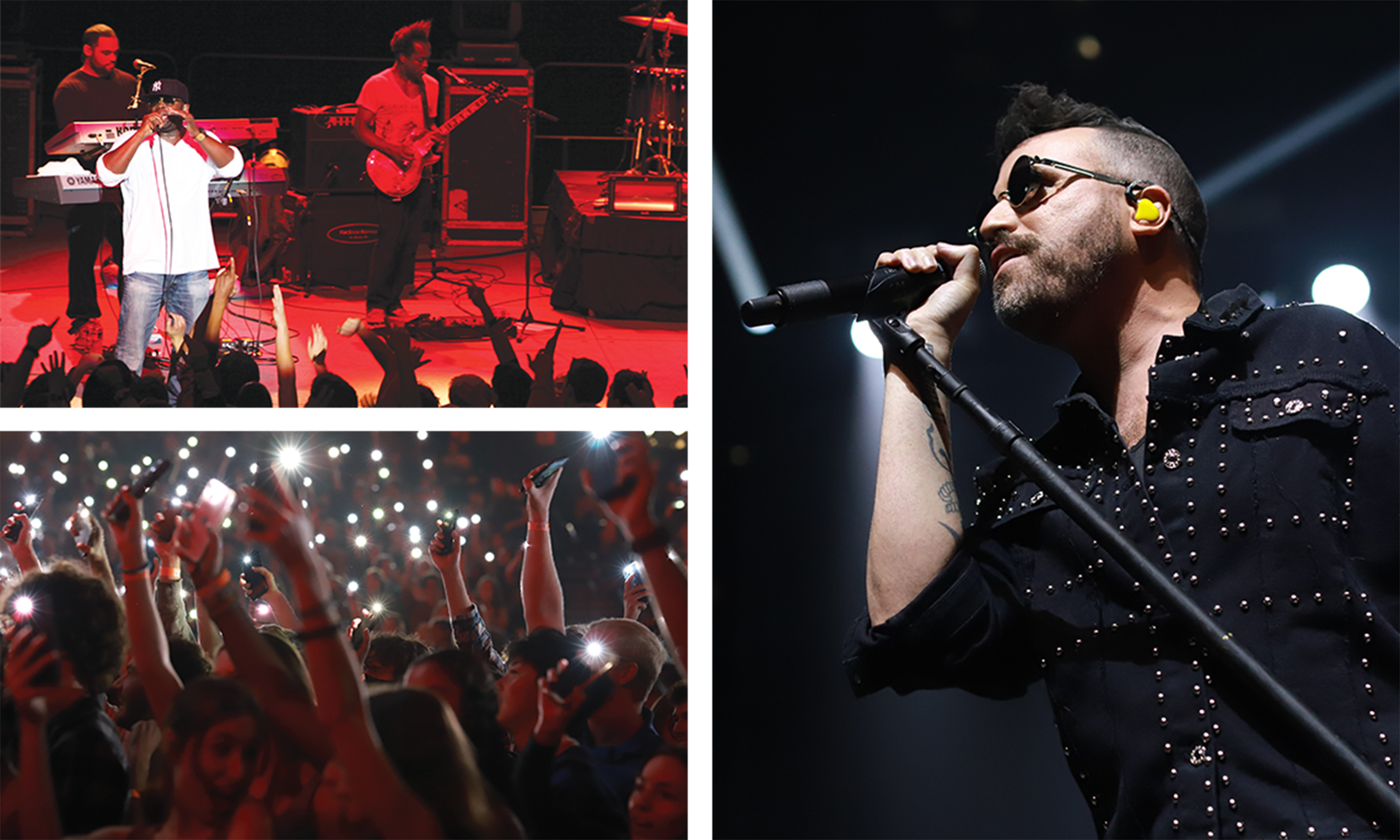
In 2008, UCAB was renamed Alma Mater Productions (AMP), but its activities and cooperation with Student Assembly (SA) continued. An article in The Flat Hat highlights the joint efforts between AMP and SA to compile resources and bring bigger acts to William & Mary. As “the direct result of individual student groups coming together to create larger events for the student body,” hip-hop group The Roots played to a packed Kaplan Arena in 2011. Drummer Ahmir “Questlove” Thompson and percussionist Frank “F. Knuckles” Walker walked through the stands to dance with students in the audience. Rapper Kendrick Lamar, fresh off the release of his first studio album, “good kid, m.A.A.d. city,” performed at Kaplan with Big Boi in 2013. The collaboration between AMP and SA to organize concerts continued in 2012, The Flat Hat reported, with a Charter Day Weekend concert featuring alternative rock band Third Eye Blind.
COOL KIDS
A little over 20 years after Nelson graduated from William & Mary, students are still organizing and planning W&M concerts through AMP. Meredith Burpeau ’24 chaired AMP’s Live Committee, which, alongside Student Assembly, organizes an annual “Welcome Back” concert in the fall and a spring concert. Burpeau remembers W&M’s first in-person “Welcome Back” concert after the COVID-19 pandemic, when indie pop band Echosmith performed at The Martha Wren Briggs Amphitheatre at Lake Matoaka in fall 2021. She doesn’t know when concerts started being held at the outdoor venue, but Burpeau notes that when she became chair of the Live Committee, she followed a tradition of holding the fall “Welcome Back” concert outdoors and the spring concert inside at Kaplan Arena.
When Burpeau joined AMP’s Live Committee, the current iteration of Nelson’s committee, she organized many of the same events, including Fridays at 5. Additionally, she planned concerts featuring big names like singer-songwriter and viral YouTuber Rebecca Black, singer and rapper Sean Kingston and indie rock band COIN.
Burpeau explains that representatives from AMP and SA still join forces to form a concert committee, organizing the fall and spring concerts with a shared budget. The headliner selection process involves using a predicted budget to create a list of desired performers. The committee follows a similar process to that of Nelson and UCAB before them. Based on the availability of performers, venue size and ticket price, the committee narrows their list and selects a headliner.
Like Strickland and Nelson before her, Burpeau was dedicated to serving the campus community’s engagement in the concert tradition. She says that AMP attempted to get artists spanning different genres. Sean Kingston, for example, appealed to pop and hip-hop fans alike. Burpeau says, “We really wanted Doechii in 2024,” a Grammy-nominated rapper and singer who rose to fame this year with the Billboard Hot 100-charting single “Anxiety.” However, students responded positively to COIN and its opener, K Camp, who together reached indie rock, rap, hip-hop and pop fans.
This past spring, Kaplan Arena welcomed Memphis rapper and songwriter NLE Choppa, whose show attracted the highest attendance in recent years.
Memorable Shows
Catch some of the well-known acts that appeared at W&M over the years.
- Grateful Dead: 1973 Concert at William & Mary Hall
- Bruce Springsteen: 1976 Concert at William & Mary Hall
- Little Feat: 1978 Concert at William & Mary Hall
- REM: Setlist for 1986 Concert at William & Mary Hall
- Nirvana: 1993 Concert at William & Mary Hall
- The Roots: 2011 Concert at William & Mary Hall
- Third-Eye Blind: 2012 Concert at William & Mary Hall
- Ludacris: 2015 Concert at William & Mary Hall
TONIGHT TONIGHT
This fall, AMP organized a new, well-attended event, “TribeChella,” on Aug. 30 in the Sunken Garden with pop-rock band Hot Chelle Rae as the headliner. Student bands Ruth & Sara, Royal Fish, F2L and Mugshot opened for the “Tonight Tonight” hitmakers. In true music festival fashion, TribeChella featured a Ferris wheel, food trucks and T-shirts for attendees.
AMP Live Committee Chair Matt Meyer ’27 views the NLE Choppa concert as a turning point for W&M concerts in terms of attendance. He believes that the excitement surrounding TribeChella is “a good indicator of what students want,” and will shape AMP’s concert planning moving forward. For now, Meyer is looking forward to reviving the “Fridays at 5” series in collaboration with AMP’s Homebrew Committee. Both committees are joining forces to increase opportunities for student musicians to participate in their live music programming.
More than a half-century after the first concert at William & Mary Hall, students still eagerly await their next chance to see a great show on campus.